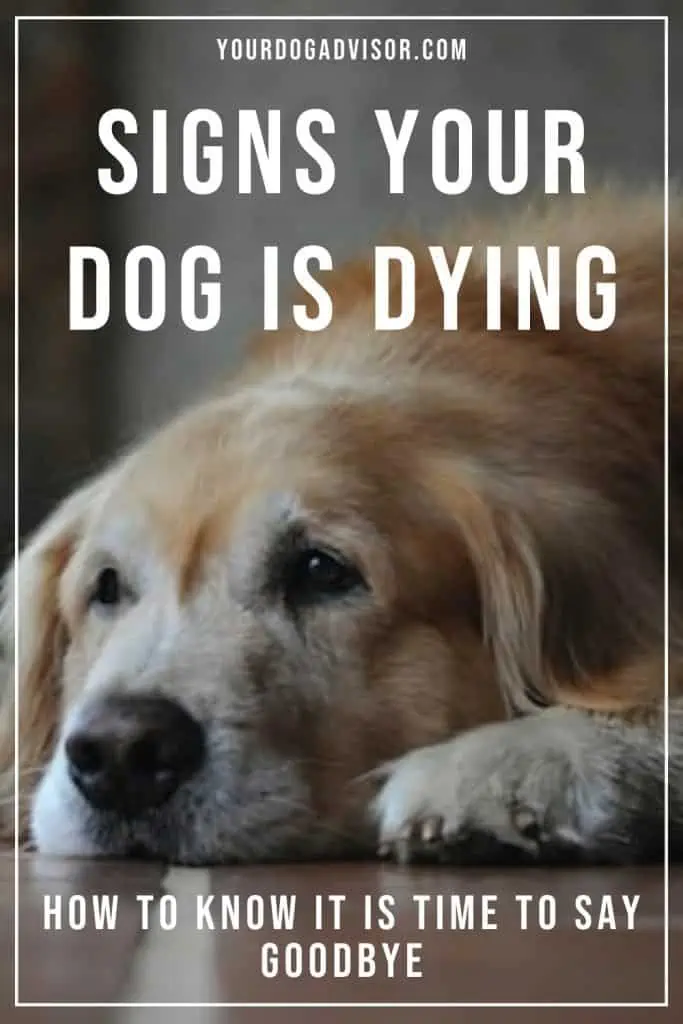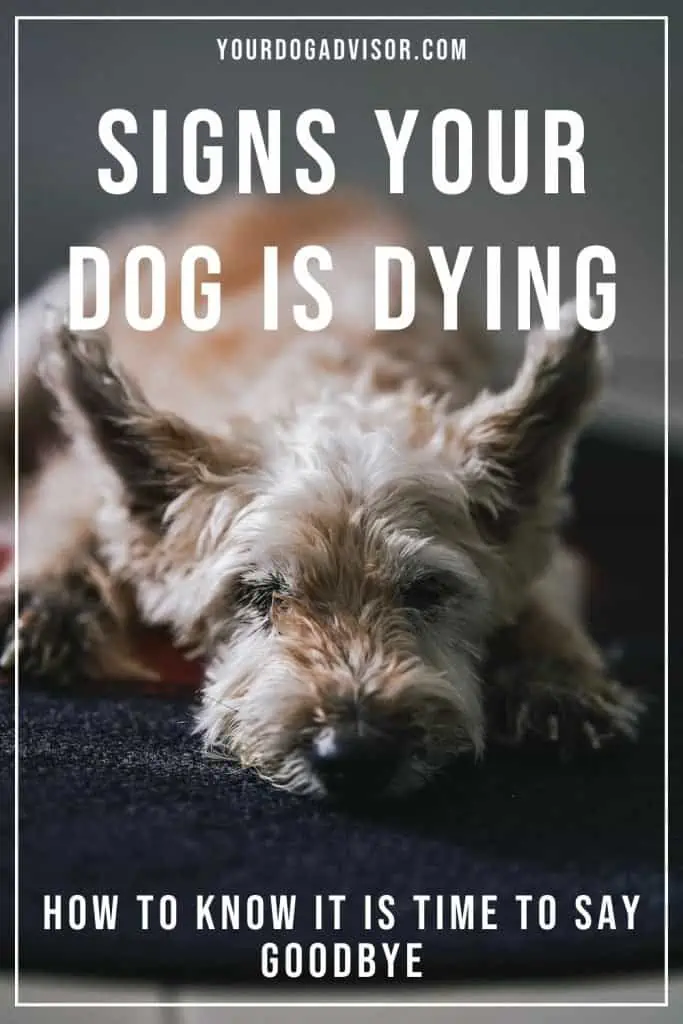If there is any downside to being a dog owner, it’s that our dogs don’t live as long as we would like. And while we all know our dog’s shorter lifespan is no secret, it’s still gut-wrenching when the sun begins to set on your time with your furry family member.
No one wants to have to say goodbye to their pet, and that’s why taking the brave step toward understanding the signs your dog is dying is commendable.
Still, it’s a difficult subject to breach, and one we want to approach with sensitivity and compassion. Most importantly, we want to help you decide what your next steps are if you do indeed feel your dog is approaching the end of his journey.
Today we are going to walk you through not only the signs your dog is dying, but what to do before, during, and after your dog passes to help ensure you have the necessary tools to manage the grief of losing your beloved pet.
Contents
But First, What Is The Average Lifespan Of A Dog?
The average lifespan of a dog can depend on many things including breed, size, weight, and genetics.
If you’re wondering about some common signs your dog is dying, one of the first things you’ll want to look at is your dog’s age to see if your dog has reached its average lifespan.
Most healthy dogs can live a decent life up until and even well past ten years old. However, some breeds have a shorter lifespan than others, and some breeds are prone to more health problems than others that can lead to a shorter lifespan.
The average lifespan of a dog also depends on its size and breed. Smaller breeds tend to live longer than larger dogs, but this is not always the case. In fact, some toy breeds can live as long as 20 years, while others live closer to 12 or 15 years. Giant dog breeds tend to have an average lifespan of between eight and 10 years, though some have a shorter lifespan of only around seven years.
And even though some dogs can live up to two decades, most dogs will be considered senior dogs by the age of seven. It’s important to keep your dog healthy and active throughout their life, but especially once they reach the age of seven to help them not only live longer but also live healthier and happier.
In general, the average lifespan for large dogs is around 10 years and for small dogs, it’s about 14 years. But why do some dogs live longer than others, and specifically why do smaller dogs tend to live longer than larger dogs?
There are many theories behind why smaller dogs can outlive their larger counterparts. Some point to the differences in metabolic rate in large and small dogs, while other studies suggest that larger dogs grow faster, thus they age faster, leaving them more prone to diseases like cancer and heart issues earlier in life.
Of course, there are exceptions to these theories and ideas. Some small breeds can be more prone to suffering from health issues that lead to them succumbing sooner, while some large dogs are hardy and have longer lifespans than most.
There are also other factors that can play a role in how long your dog will live on average, too, including:
- Breed
- Size
- Weight
- Genetics
- Environment
- Exercise
- And diet
To determine your unique dog’s lifespan, it’s best to research the specific breed or mix you have. This will give you a better idea of how long your dog might live on average.
And if you do have a dog that is reaching the brink of its average lifespan, you may be wondering which of the signs your dog is dying that you should look out for.
On the other hand, even if your dog is young and should otherwise be healthy, it’s still wise to know the signs your dog is dying so that you can potentially catch problems early enough to stall or even prevent premature death.
Keep reading to learn more.
Here Are Some Common Signs Your Dog Is Dying And What You Can Do About It
Remember that not all signs your dog is dying are actual signs your dog is going to die. There may be steps you can take to prevent death if you catch the signs early.
It can be difficult to determine whether or not your dog is dying, and it’s much easier to identify the signs your dog is dying when your dog is older and already reaching the end of his natural life. However, even young dogs can suddenly begin to show signs they are dying.
Below are some common signs your dog is dying you should be aware of regardless of if you have a senior dog or a young dog.
- Changes in appetite
- Lethargy or Lack Of Interest In Play, Walks, or Other Things They Enjoy
- Incontinence or Vomiting
- Excessive panting and inability to catch breath
- Seizures and shaking
- Confusion
- Wanting To Be Left Alone Or Wanting To Be Closer To You
- Loss of Coordination
- Refusal To Drink Water
- Slowed Breathing
- A Change In The Way Your Dog Smells
- Restlessness or An Inability To Get Comfortable
- Sudden Changes in Temperament
- Extreme Weight Loss
- Trouble Breathing
- Hardened or Distended Stomach
- And Loss of Consciousness
If you believe your dog has gotten into something like poison, some signs your dog is dying and needs emergency medical help include:
- Vomiting
- Extreme Salvation
- Loss of Appetite
- Nausea or Dry Heaving
- A Racing Heartbeat
- Yellowing Gums
- Pale Gums
- Strange Or Unusual Behavior
- Coughing Up Blood
- Vomiting Up Blood
- Blood In Stool or Tarry Looking Stool
- Lethargy
- Weakness
- Decreased Urination
- Diarrhea
- Inability to Walk
- Falling Down When Trying To Walk
- And Eventual Collapse
If you notice any of the above signs your dog is dying and you think your dog has been poisoned or gotten into something toxic, contact your emergency vet immediately and get your dog seen as quickly as possible.
If you have specific questions or concerns regarding toxic substances or if you believe your dog has been poisoned but aren’t sure, you can contact the Animal Poison Control Hotline at (888) 426-4435 or visit the ASPCA.
What To Do If You Think Your Dog Is Dying
For most young and healthy dogs, and even for many healthy senior dogs, some of the above signs your dog is dying could really just be a sign your dog is sick or injured.
Still, if you see any of the above signs in your pet, regardless of its age or health, it’s important to take your dog to your veterinarian right away.
When It Is Time Say Goodbye To Your Dog – How To Prepare
When your dog’s death is inevitable, it’s important to prepare as best you can.
If you get a diagnosis that your dog is going to pass away, you may already be prepared for some of the signs your dog is dying. However, you may not be aware of what to look out for over time.
Knowing your dog is getting ready to pass but not knowing how soon this will happen can be nerve wracking and distressing. It’s important to know you do have different options if your dog is dying as well. These options include helping your dog pass away peacefully by having him put to sleep to reduce pain or suffering, or you may choose to allow your dog to pass away at home naturally without the help of medical intervention.
People have strong opinions about both options, but it’s important to know that not every option is right for every owner or dog, and that’s okay.
Perhaps the easiest way to make this decision once your dog reaches the end of its life is to consider your dog and its overall quality of life. If the signs your dog is dying indicate that your dog is in pain, your veterinarian will likely recommend putting your dog to sleep in order to reduce its suffering.
However, some dog owners prefer to keep their dogs at home and allow them to pass away naturally, especially if their dog is not in a lot of pain or if their dog becomes especially distressed when going to the veterinarian. Another option is to have a veterinarian trained in euthanasia visit your home.
Before you make a decision, there is a timeline of different signs your dog is dying that you might want to be aware of.
Three Months Before Your Dog Passes Away
- Dehydration
- Gastrointestinal Changes
- Changes In Appetite and Water Intake
- Weight Loss
- Dullness In The Eyes
- Reduced Self Grooming
- Restlessness
- An Inability To Get Comfortable
Three Weeks Before Your Dog Passes Away
- Excessive Weight Loss
- Change in Sleep Patterns
- Loss of Interest In Fun Activities
- Increased Isolation
- Skin Problems
- Discharge of the Eyes
- Picky Eating or Food Aversions
- Confusion
Three Or So Days Before Your Dog Passes Away
- Continued Excessive Weight Loss
- Confusion
- Increased Restlessness or Unusual Stillness
- A Change In Your Dog’s Scent
- A Change In Your Dog’s Temperament
- Isolation
- Lack Of Interest In Socializing
- Lack of Appetite
- And Lack of Water Intake
For Senior Dogs In Their Final Years and Months, Keeping Them Comfortable Is Important
It is important to keep your dog as comfortable as possible as he enters his golden years.
You may have heard that all senior pets experience distress as they age, and though aging does have its fair share of aches and pains, not all senior dogs need to suffer. There are many ways to help ensure your senior dog is as comfortable as possible as they near the end of their life.
Like humans, dogs not only show age in how they look but also in how they move and behave. As pets grow older, they may experience weakened bones and joints as well as a decrease in vision and hearing, which can make them more vulnerable to injury.
Dogs also become less active with age, which means they may not eat as much as they did when they were young, which will likely require them to be on a specific diet to ensure they are getting all the proper nutrients they need to stay healthy and fit.
And although senior dogs may not be as active as they once were in their youth, light exercise is still important to help reduce pain from arthritis and joint swelling.
Making sure your senior dog has proper bedding can also help reduce pain and discomfort from aging bones and joints, as can proper supplements and vitamins.
If you have an aging dog, we’re sure you want to do whatever you can to ensure they are as happy and comfortable as possible. Below are a few top-rated products you can invest in to help ensure your dog not only lives a longer life but also a happier life.
Take a look.
The Dog’s Bed Orthopedic Memory Foam Dog Bed
No products found.
The Dog’s Bed Orthopedic Memory Foam Dog Bed is a great option for older dogs who may be having joint problems. This bed comes in three sizes including small, medium, and large. It features a memory foam base that molds to your dog’s body, providing support and comfort to achy joints.
We like that this dog bed is designed to provide comfort and support for older dogs with joint issues or other ailments that make it hard for them to get comfortable while at rest. The design of this bed not only makes it easier for dogs to find a comfortable position while they are at rest, but the bed can also help support your dog as he lays down and gets up.
Pet Honesty 10 in 1 Multivitamin For Dogs
No products found.
Pet Honesty 10 in 1 Multivitamin For Dogs is a vitamin supplement for dogs that helps to improve their health and well-being overall. It has been specially formulated to help your dog’s body fight off infections, boost immunity and maintain healthy joints. It also contains vitamins and minerals that are essential for maintaining good health in senior dogs.
The product contains calcium, magnesium, and zinc which are all essential nutrients dogs need more of as they age. These ingredients are known to help support healthy bones, skin, hair, and nails which are especially important as older dogs tend to lose some of their outer coat due to a lack of protein or zinc deficiency.
Blue Buffalo Senior Wet Dog Food
No products found.
Senior dogs can become more susceptible to illness and disease as they age, as we mentioned in our list of signs your dog is dying. The immune system becomes weaker, which makes your dog more vulnerable to infections, diseases, and other health problems. By feeding your senior dog quality dog food specified for your dog’s age and weight, you can help support their immune system so that they stay healthier for longer.
Blue Buffalo Senior Wet Dog Food is a quality dog food specially formulated for senior dogs. It contains glucosamine and chondroitin to help support healthy joints, as well as omega fatty acids to promote good skin and coat health. This dog food also contains natural antioxidants to help support a healthy immune system.
The Do’s And Don’ts When It Comes To Your Dying Dog – What Experts Recommend
Remember to try and make end of life decisions that are best for your dog and his overall quality of life.
Once you recognize the signs your dog is dying, it’s normal to feel devastated, afraid, angry, and lost. It’s not just your dog that is suffering. You are also going through an emotional roller coaster as you watch your beloved pet fade away.
It’s common to feel heartbroken at even the mere thought of losing your dog, and you’re not alone — millions of people experience pet loss every year. And while you may be tempted to do anything to prolong your dog’s life, there are certain things you should keep in mind when it comes to letting your pet go peacefully and on their terms.
Here are some tips from veterinarians and other experts about how to best care for your dying dog:
First, don’t deny the reality that your dog is ill or injured and won’t recover — even if it breaks your heart. It’s important to let go of fantasies that things will magically get better once you’ve received a terminal diagnosis.
Of course, this does not mean you shouldn’t seek second opinions or research your options, especially if your dog is younger than his average lifespan or if the illness has come on suddenly. However, once it has been surly determined that your dog is going to pass, it’s important you try to be present for your pet so you can do your best to comfort him during his passing.
It’s also a good idea to make sure your dog receives plenty of love and attention from you and other family members while also ensuring the environment around your dog is calm, peaceful, and quiet. This will help your dog feel safe and comfortable as they near the end of their life, and it can also help comfort you to have the support of your family members who are feeling the same way you are.
Remember, while dogs are intuitive and often much smarter than people give them credit for, you shouldn’t expect your dog to understand what is happening when they’re sick or injured. If your dog’s temperament changes as he nears the end of his life, don’t take it personally.
Many dogs isolate themselves or prefer not to be snuggled, cuddled, or held when they get close to passing, and this is normal. Remind yourself that your dog’s comfort is most important during this time, and it’s your job to help him transition on his terms.
And last, if you have read through the list of signs your dog is dying and you have received a diagnosis from a trusted veterinarian that your pet is passing away and is in pain, try to consider what is best for your dog, not what is easiest for you.
This may mean allowing your dog to die peacefully by having your dog put to sleep, especially if prolonging your dog’s life will only exacerbate any pain or suffering he may have.
After The Goodbye – Our Tips For Coping And Support
Grieving a pet is incredibly difficult, but there are some tips to help you cope.
The death of a dog is a devastating loss, and you’re certainly not alone in your grief. In fact, losing a beloved dog is often just as difficult as losing any other important family member. The bond between dogs and their people runs deep, and the death of a dog can be traumatic for both other dogs in the home and owners alike.
Here are some tips for coping with the death of a dog:
First, it’s important to allow yourself time to grieve and talk about your loss. It’s okay to cry and express your emotions to trusted people in your life you can rely on. Talk to friends and family members who have also lost a pet and lean on them for support and advice. But with that said, also remember that everyone grieves differently. There is no right or wrong way to grieve the loss of your dog.
You might also consider getting counseling. If you feel like you need professional help dealing with your grief, talk to your doctor about resources or research options in your area. There are likely many pet loss support groups available in your area to help you manage your pain and cope with your loss.
It can also help to do something physical after the loss of a pet. Try taking up a new activity, such as running or walking, swimming or biking. Exercise releases endorphins in your body that can help make you feel better about yourself and help reduce stress levels.
Last, you might find that donating time or funds in your dog’s memory can help you to cope. You may even find that fostering dogs in need can help fill a small piece of the big hole left behind from your pet’s passing.
Whatever you choose to do, there is no right or wrong way to grieve the loss of a pet. We just hope this article has been helpful in guiding you not only through the signs your dog is dying but also how to manage once it’s time to say goodbye to your furry family member.
If you have recently lost your dog, we are sincerely sorry for your loss and wish you all the best in your healing as you move forward.


Jen Jones is a professional dog trainer and behavior specialist with more than 25 years of experience. As the founder of ‘Your Dog Advisor’ and the ‘Canine Connection’ rehabilitation center, she applies a holistic, empathetic approach, aiming to address root causes rather than merely treating symptoms.
Well known for her intuitive and compassionate approach, Jen adopts scientifically-proven, reward-based methods, encouraging positive reinforcement over punishment. Jen specializes in obedience training, behavior modification, and puppy socialization. Her innovative methods, particularly in addressing anxiety and aggression issues, have been widely recognized. Jen has worked with many of the world’s leading dog behaviorists and in her free time volunteers with local animal shelters and rescue groups.






